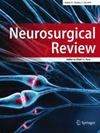摘要
术后恢复强化方案(ERASP)可改善术后效果。然而,ERASP 在神经外科手术中的应用仍处于探索阶段,因此缺乏标准的循证指南。因此,我们比较了ERASP和常规围手术期护理(CPC)对因各种颅内病变接受择期开颅手术患者的疗效。本系统综述和荟萃分析在 2024 年 12 月 4 日前对 PubMed、Cochrane Library 和 Google Scholar 进行了检索。主要结果是总住院时间和术后住院时间(LOS)。次要结果包括住院费用、疼痛、镇痛药使用、卡诺夫斯基表现状态(KPS)评分、术后恶心呕吐(PONV)、术后并发症、30 天再入院和再次手术以及死亡率。共纳入了 15 项研究,包括随机对照试验(9 项)以及前瞻性和回顾性研究(各 3 项)。与 CPC 相比,ERASP 可显著降低总 LOS(MD -3.32,95%CI -3.66~-2.98;P 2 = 34%)、术后 LOS(MD -2.80,95%CI -3.82~-1.79;P 2 = 90%)、住院费用(MD -1044美元,95%CI -1289~-800美元;P 2 = 47%)、术后疼痛(MD -1.55,95%CI -1.92~ -1.19;P 2 = 83%)、镇痛剂使用(OR 0.56,95%CI 0.40 至 0.80;P = 0.001,I2 = 0%)、KPS 评分(MD 6.68,95%CI 0.15 至 13.21;P = 0.045,I2 = 93%)、呼吸系统并发症(OR 0.28,95%CI 0.13 至 0.58;P = 0.001,I2 = 0%)和 PONV(OR 0.39,95%CI 0.27 至 0.57;P 2 = 0%)。而 ERASP 和 CPC 在其他结局指标方面具有可比性。因此,在择期开颅手术中,ERASP 可缩短总住院时间和术后住院时间,降低住院费用,改善功能恢复,减少疼痛和镇痛药的使用,降低 PONV 和呼吸系统并发症的发生率。Enhanced recovery after surgery protocol (ERASP) improves postoperative outcomes. However, its implementation in neurosurgery remains under explored, resulting in the absence of standard evidence-based guidelines. Thus, we compared the outcomes of ERASP and conventional perioperative care (CPC) in patients undergoing elective craniotomy for various intracranial pathologies. This systematic review and meta-analysis involved the search of PubMed, Cochrane Library, and Google Scholar until December 4, 2024. The primary outcomes were total and postoperative length of stay (LOS). Secondary outcomes included hospitalization cost, pain, analgesic use, Karnofsky performance status (KPS) score, postoperative nausea and vomiting (PONV), postoperative complications, 30-days readmission and reoperation, and mortality. A total of 15 studies, including randomized controlled trials (n = 9) as well as prospective and retrospective studies (each n = 3) were included. Compared to CPC, ERASP significantly reduced total LOS (MD -3.32, 95%CI -3.66 to -2.98; P < 0.0001, I2 = 34%), postoperative LOS (MD -2.80, 95%CI -3.82 to -1.79; P < 0.0001, I2 = 90%), hospitalization cost (MD -$1044, 95%CI -$1289 to -$800; P < 0.0001, I2 = 47%), postoperative pain (MD -1.55, 95%CI -1.92 to -1.19; P < 0.0001, I2 = 83%), analgesic use (OR 0.56, 95%CI 0.40 to 0.80; P = 0.001, I2 = 0%), KPS score (MD 6.68, 95%CI 0.15 to 13.21; P = 0.045, I2 = 93%), respiratory complications (OR 0.28, 95%CI 0.13 to 0.58; P = 0.001, I2 = 0%), and PONV (OR 0.39, 95%CI 0.27 to 0.57; P < 0.0001, I2 = 0%). While ERASP and CPC were comparable regarding other outcome measures. Thus, in elective craniotomy, ERASP shortens total and postoperative LOS, decreases hospitalization costs, improves functional recovery, decreases pain and analgesic use, with reduced incidence of PONV and respiratory complications.

 求助内容:
求助内容: 应助结果提醒方式:
应助结果提醒方式:


